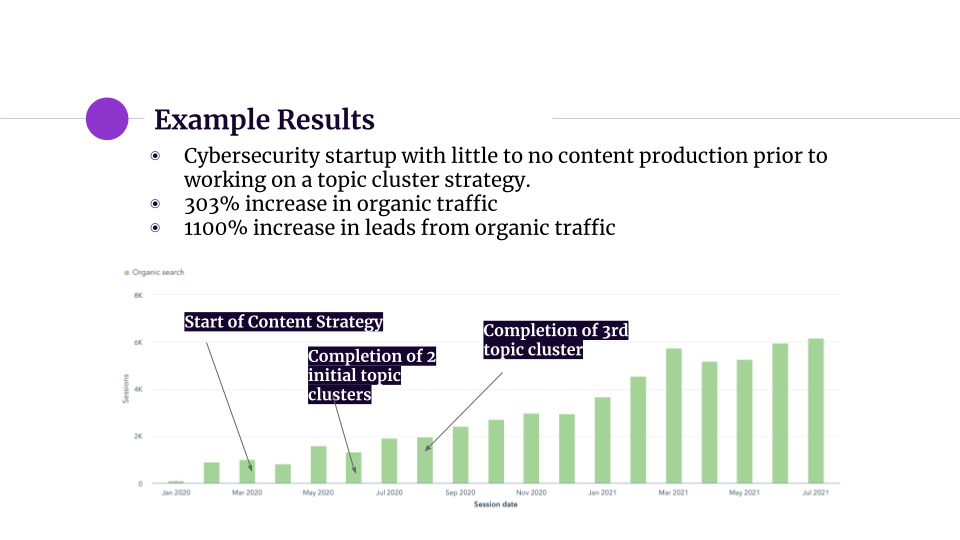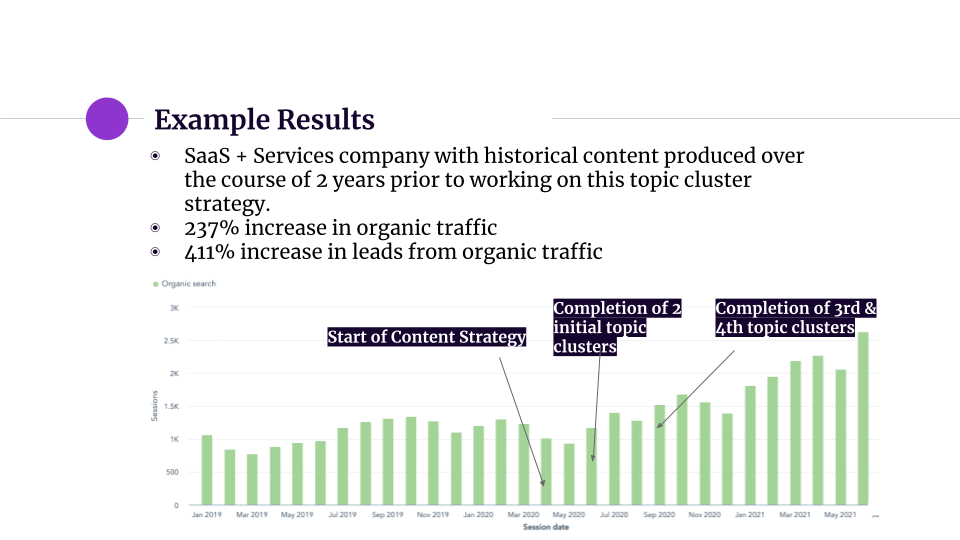How Long Do Topic Clusters Take to Work?
Ah, the age-old content marketing question: “When will I see results?”
An important question, to be sure, but a loaded one.
Before we go too much further: topic clustering, and SEO work in general, is a long-term play. Anyone who tells you ANYTHING different is blowing smoke up your butt. But it is a really, really good long term play.
Why?
Once you’ve gained the traffic, it is highly likely to stay “your traffic” and you won’t have to keep paying for it month in and month out.
Content is typically the foundation for any other digital marketing strategy, so you need it anyway. Want to run paid ads? Great, where are you going to send them? I’ll tell you where: to content.
It builds on itself. Once you get the machine going, it gets much easier to keep the flywheel cranking.
Depends on what you mean by “work”
Before we jump into providing timelines and expectations, let’s start by defining what we mean by “work.”
For most, the definition of how long it takes a topic cluster strategy to work is based on how long they should expect to have to wait for organic traffic to increase. And that is a valid question, one which I’ll answer in the next section.
But, keep in mind that content can “work” for you in a lot more ways than just driving organic traffic. So, if you build both your pillar content and cluster content to work in various ways, you can make it “work” for you in driving qualified leads and creating positive interactions with your target market right away. So, make sure you stick around after the section on SEO results to learn how to do that.
How long it takes for them to generate SEO results
General guidance
How fast your topic cluster strategy will start earning you significant increases in traffic depends primarily on three things:
What is your current state?
What is your volume of content creation or production?
How competitive are the keywords you are targeting?
Let’s dig into each in more detail:
What is your current state? This is a combination of many things, namely how much traffic you currently have (the more you already have, the quicker you can pick up keywords and generate increases in traffic), how much existing content you’ve already produced on a core topic (the more you already have, the faster your path to ranking).
What is your content creation or production volume? This is simply a measure of how frequently you are producing and launching content. I recommend no fewer than publishing 2x per week to really make sure you are moving the needle. The faster you can produce, the faster your results.
How competitive are the keywords you are targeting? This is a measure of how many other websites are out there trying to rank for the same keywords you are targeting with a particular content cluster. Higher competition means longer time to ranking and results.
How to measure
Over the last 7 years, I’ve run enough of these strategies to figure out some averages and set some expectations on how long rankings, and ultimately traffic, will take to increase.
I recommend tracking two things. Okay, more than two things, but the things to measure fall into two categories.
Leading Indicators: Metrics that indicate the strategy is working early after launch, before it starts delivering lagging indicators like traffic.
Key Results: Lagging indicators that show the cluster generated results to prove the ROI of having created it.
Both groups are important.
Leading indicators help you to determine if a cluster is on its way to delivering the key results you want, and the act of checking them regularly often raises opportunities for you to optimize pieces of the cluster in order to ensure it will deliver the desired results. Thus, just the simple act of measuring leading indicators often CAUSES the key results to fall into place.
Some of the leading indicators I track to see if a strategy is on the right path are:
Initial ranking for sub-topic blog post keywords: Expect to start to see some of the smaller volume, more detailed keywords you targeted during your keyword research phase for your sub-topic blogs to show up somewhere in the rankings (I use SEMRush to keep track of all my rankings). This should start to happen somewhere in the first month or two. The higher your domain authority, the faster it will happen.
Increased ranking for sub-topic blog post keywords: In the first couple months, you should be watching for these keywords to climb in the rankings, moving farther and farther up in the listings.
Potential initial ranking for cluster or pillar keyword: After some time, you can expect to start to see your topic area keyword, or pillar keyword, somewhere around months 2-4, depending on how competitive the keyword is and your current domain authority.
Key results help you determine how much a topic area resonated with your audience (e.g. the amount of traffic to the page), how useful the topic cluster content was to your audience (e.g. your conversion rate). and how relevant it is to your ideal customers (e.g. the number of closed deals that can be attributed to it). These learnings often help to inform future clusters or topic areas to add to your overall content strategy.
Some of the key results I track to see if a topic cluster strategy is performing as desired are:
Sub-topic blog traffic: After you start to see your sub-topic blogs climbing in the rankings, you should start to see measurable organic traffic coming in on those pages.
Pillar traffic: In a similar fashion, as your pillar keyword rises in rankings, you should start to see measurable organic or search engine fueled traffic to that page.
Cluster traffic: I measure the success of a cluster from a traffic perspective by looking at the traffic to ALL of the topic cluster pages defined in the cluster strategy. Keep in mind that one blog may really take off, and some may get very little traffic. But the success of those that do take off in traffic is because of the entire cluster, so don’t abandon the ones that aren’t getting much, they are still a vital part of the overall strategy.
The bottom line is this:
Low competition keywords typically show all the leading indicators in the first 2 months following launch, and can take up to 4 months for all of the lagging indicators to truly show major results.
High competition keywords typically show all the leading indicators in the first 2-4 months following launch, and can take up to 4-6 months for all of the lagging indicators to truly show major results.
Snowball effect
Keep in mind that the longer you follow a topic cluster model with how you organize your entire content strategy (e.g. you create the majority of your content in clusters), your effects will start to happen faster and faster each time you produce them.
Ultimately it turns into a snowball effect that shows results like these graphs:
Make them work for you in the immediate term
Now the most important question: Why on earth would you wait to get value out of this great content you are producing? Get some right away.
Here are some ideas:
Target content that answers key questions in the sales process then arm your sales team with it immediately. Have them use it to shorten and simplify their sales cycle. (Yay! More money, faster!)
Find key distribution channels. You are (or at least should be) creating cluster content specifically to answer questions your target audience might have. Find ways to get in front of your target audience to share like participating in online communities, sharing through social media, pushing it via paid advertising, etc.
Essentially: Find where your audience lives, and let them know the content exists. If it is helpful enough, the rest will be done for you!
Pillar pages are great for this as they are usually "the complete guide" to a subject area and can be used to answer a number of questions.
Want the Playbooks?
Want detailed playbooks on how to expertly build a topic cluster, from strategy to completion? Looking for more training on how to execute topic clusters successfully (because, let’s be honest, you probably already know you need to do them).
Check out my online course, which compiles nearly 10 years of experience in content strategy and detailed instructions on how to execute a topic cluster strategy to perfection.



